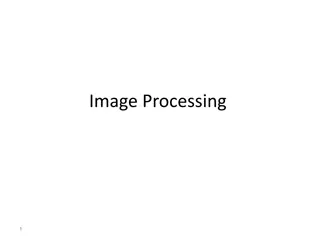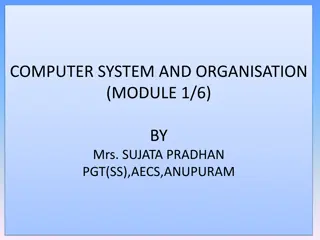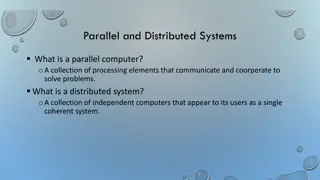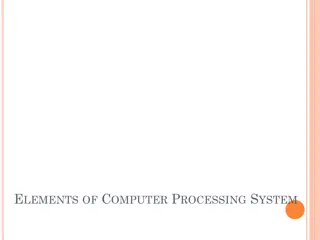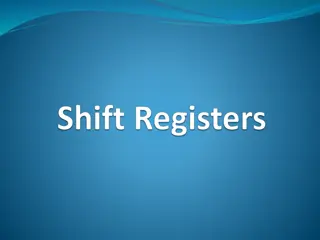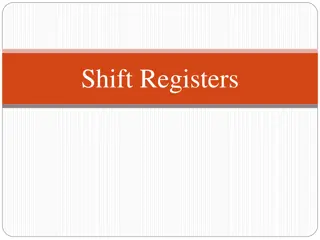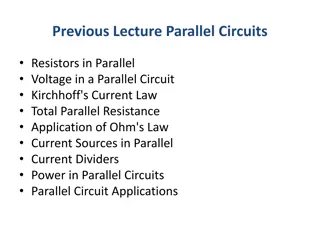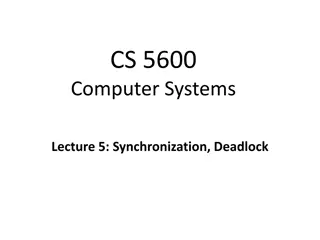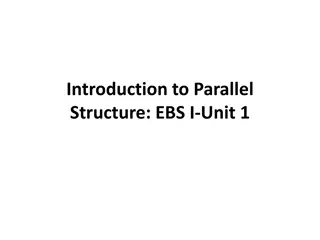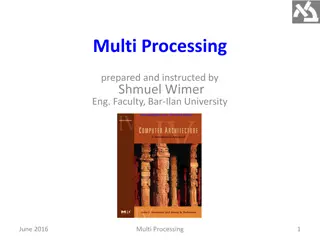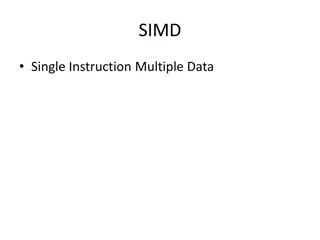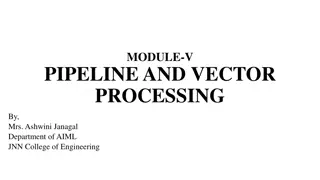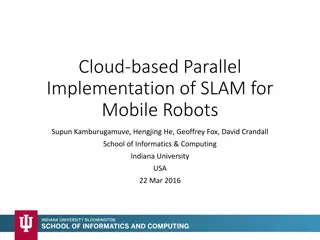Parallel Processing in Computer Organization
Computers can be classified based on data and instruction streams, forming various types of structures. Parallel processing levels can be defined based on instruction and data stream categorization, proposed by Michael Flynn in 1972. The instruction cycle consists of steps needed for executing instructions in a program. Control units fetch and decode instructions, executing them with temporary storage in Memory Data Registers. Streams refer to the flow of either instructions or data within the computer cycle, categorizing computer organization based on the minimum number of streams flowing at any point in execution.
Download Presentation

Please find below an Image/Link to download the presentation.
The content on the website is provided AS IS for your information and personal use only. It may not be sold, licensed, or shared on other websites without obtaining consent from the author.If you encounter any issues during the download, it is possible that the publisher has removed the file from their server.
You are allowed to download the files provided on this website for personal or commercial use, subject to the condition that they are used lawfully. All files are the property of their respective owners.
The content on the website is provided AS IS for your information and personal use only. It may not be sold, licensed, or shared on other websites without obtaining consent from the author.
E N D
Presentation Transcript
Parallel based on the data and instruction streams forming organisations. computers can be characterized various types of computer They can also be classified based on the computer structure, e.g. multiple processors having separate memory or one shared global memory. Parallel processing levels can also be defined based program called grain size. on the size of instructions in a
This proposed by Michael Flynn in 1972. classification was first studied and He introduced the concept of instruction and data streams for categorizing of computers. Since, instruction and data streams, first we need to understand how the instruction cycle works. this classification is based on
The instruction cycle consists of a sequence of steps needed for the execution of an instruction in a program. A typical instruction in a program is composed of two parts: Opcode and Operand. The Operand part is divided into two parts: addressing mode and the Operand. The addressing mode specifies the method of determining the addresses of the actual data on which the operation is to be performed and the operand part is used as an argument by the method in determining the actual address.
The control unit of the CPU of the computer fetches instructions in the program, one at a time. The fetched Instruction is then decoded by the decoder which is a part of the control unit and the processor executes the decoded instructions. The result of execution is temporarily stored in Memory Memory Data Register). Buffer Register (MBR) (also called
The term stream refers to a sequence or flow of either instructions or data operated on by the computer. In the complete cycle of instruction execution, a flow of instructions from main memory to the CPU is established. This stream between This instructions there is is a a flow processor and flow of flow of called flow of bi- -directionally called data is instruction of operands directionally. . stream. . instruction operands stream. . Similarly, between processor This flow Similarly, there and memory memory bi data stream of operands operands is is called
Let Isand Dsare minimum number of streams flowing at any point in the execution, then the computer organisation can be categorized as follows: 1. Single Instruction and Single Data stream (SISD) In this organisation, sequential execution of instructions is performed by one CPU containing a single processing element (PE), i.e., ALU under one control unit. Therefore, SISD machines are conventional serial computers that process only one stream of instructions and one stream of data. Single Instruction and Single Data stream (SISD) 1.
2 2. . Single Single Instruction In this organization, multiple processing elements work under the control of a single control unit. It has one instruction and multiple data stream. All the processing elements of this organization receive the same instruction broadcast from the CU. Instruction and and Multiple Multiple Data Data stream stream (SIMD) (SIMD) Main memory can also be divided into modules for generating multiple data streams acting as a distributed memory. Therefore, execute the same instruction . all the processing elements simultaneously Each processor takes the data from its own memory and hence it has on distinct data streams.
3) Multiple Instruction and Single Data stream (MISD) 3) Multiple Instruction and Single Data stream (MISD) In this organization, multiple processing elements are organised under the control of multiple control units. Each control unit is handling one instruction stream and processed through its corresponding processing element. But each processing element is processing only a single data stream at a time. Therefore, for handling multiple instruction streams and single data stream, multiple control units and multiple classification. processing elements are organized in this All processing elements are interacting with the common shared memory for the organization of single data stream
MISD organisation can be very helpful. For example, Real time computers need to be fault tolerant where several processors execute the same data for producing the redundant data. All these redundant data are compared as results which should be same; otherwise faulty unit is replaced.
4) Multiple Instruction and Multiple Data stream (MIMD) In this organization, multiple processing elements and multiple control units are organized as in MISD. But the difference is that now in this organization multiple instruction streams operate on multiple data streams . Therefore, for handling multiple instruction streams, multiple control units and multiple processing elements are organized such that multiple processing elements are handling multiple data streams from the Main memory. The processors work on their own data with their own instructions. Tasks executed by different processors can start or finish at different times. This classification actually recognizes the parallel computer. All multiprocessor systems fall under this classification. Of the classifications discussed above, MIMD organization is the most popular for a parallel computer. In the real sense, parallel computers execute the instructions in MIMD mode. 4) Multiple Instruction and Multiple Data stream (MIMD)
Flynns classification discusses the behavioural concept and does not take into consideration the computer s structure. Parallel computers can be classified based on their structure also.
As computer characterised as a set of multiple processors and shared memory or memory modules communicating via an interconnection network. When multiprocessors communicate through the global shared memory modules then this organisation is called Shared memory computer or Tightly coupled systems. we have seen, a can parallel (MIMD) be Similarly when every processor in a multiprocessor system, has its own local memory and the processors communicate transmitted between their local memories, then this organisation is called computer system via messages Distributed or Distributed or memory coupled memory coupled computer system. . Loosely Loosely
Every processor communicates through a shared global memory. For high speed real time processing, these systems are preferable as their throughput is high as compared to loosely coupled systems. multiple processors share a global main memory, which may have many modules. The processors have also access to I/O devices. The inter- communication between processors, memory, and other devices are implemented through various interconnection networks
When a processor wants to send an interruption to another processor, then this interrupt first goes to ISIN, through which it is synchronization between processor is implemented by ISIN. Moreover, in case of failure of one processor, ISIN can broadcast the message to other processors about its failure. passed to the destination processor. In this way,
Since, every reference to the memory in tightly coupled systems is via interconnection network, there is a delay in executing the instructions. To reduce this delay, every processor may use cache memory for the frequent references made by the processor.
These systems do not share the global memory because shared memory concept gives rise to the problem of memory conflicts, which in turn slows down the execution of instructions. Therefore, to alleviate this problem, each processor in loosely coupled systems is having a large local memory (LM), which is not shared by any other processor. Thus, such systems have multiple processors with their own local memory and a set of I/O devices. These computer systems are connected together via message passing interconnection network. Since every computer system or node in multicomputer systems has multicomputer systems. These are also called loosely coupled systems, meaning that nodes have little coupling between them a separate memory, they are called distributed
Since local memories are accessible to the attached processor only, no processor can access remote memory. Therefore, these systems are also known as no-remote memory access (NORMA) systems
This classification is based on recognizing the parallelism in a program to be executed on a multiprocessor system. The idea is to identify the sub-tasks or instructions in a program that can be executed in parallel. For example, there are 3 statements in a program and statements S1 and S2 can be exchanged. That means, these are not sequential as shown in Figure 15. Then S1 and S2 can be executed in parallel.
But it is not sufficient to check for the parallelism between statements or processes in a program. The decision of parallelism also depends on the following factors: Number and types of processors available, i.e., architectural features of host computer Memory organisation. Dependency of data, control and resources.
As discussed above, parallel computing requires that the segments to be executed in parallel must be independent of each other. So, before executing parallelism, all the conditions segments must be analyzed. In this section, we discuss three types of dependency segments. of parallelism between the conditions between the
It refers to the situation in which two or more instructions share same data. The instructions in a program can be arranged based on the relationship of data dependency; this means how two instructions or segments are data dependent on each other. The following types of data dependencies are recognised
i i) ) Flow becomes input of I2, then I2 is said to be flow dependent on I1. Flow Dependence Dependence : If instruction I2 follows I1 and output of I1 ii) ii) Antidependence output of I2 overlaps with the input of I1 on the same data. Antidependence : When instruction I2follows I1such that iii) I1 and I2 overlap on the same data, the instructions are said to be output dependent. iii) Output Output dependence dependence : When output of the two instructions iv) instructions are invoked on the same file, it is a situation of I/O dependence. iv) Input Input dependence dependence : When read and write operations by two
Consider the following program instructions: I1: a = b I2: c = a + d I3: a = c In this program segment instructions I1and I2are Flow dependent because variable a is generated by I1as output and used by I2as input. Instructions I2 and I3are Antidependent because variable a is generated by I3but used by I2and in sequence I2 comes first. I3is flow dependent on I2because of variable c. Instructions I3and I1are Output dependent because variable a is generated by both instructions.
Instructions or segments in a program may contain control structures. Therefore, dependency among the statements can be in control structures also. But the order of execution in control structures is not known before the run time. Thus, control structures dependency among the instructions must be analyzed carefully. For example, the successive iterations in the following control structure are dependent on one another. For ( i= 1; I<= n ; i++) { if (x[i - 1] == 0) x[i] =0 else x[i] = 1; }
The parallelism between the instructions may also be affected due to the shared resources. If two instructions are using the same shared resource then it is a resource dependency condition. For example, floating point units or registers are shared, and this is known as ALU dependency. When memory is being shared, then it is called Storage dependency.
For instructions in parallel, it should be ensured that the instructions are independent of each other. These instructions can be data dependent / control dependent / resource dependent on each other. Here we consider only data dependency among the statements execution. A A. .J J. . Bernstein dependency which or execution of instructions or block of for taking decisions of parallel Bernstein has dependency and which we or processes has elaborated and derived we can processes. . elaborated the derived some can decide the work conditions based parallelism of work of of data based on instructions data on some conditions the parallelism decide the of instructions
Bernstein conditions are based on the following two sets of variables: i) The Read set or input set RIthat consists of memory locations read by the statement of instruction I1. ii) The Write set or output set WI that consists of memory locations written into by instruction I1. The sets RI and WI are not disjoint as the same locations are used for reading and writing by SI.
The following are Bernstein Parallelism conditions which are used to determine whether statements are parallel or not: 1) Locations in R1 from which S1 reads and the locations W2 onto which S2 writes must be mutually exclusive. That means S1 does not read from any memory location onto which S2 writes. It can be denoted as: R1 W2= 2) Similarly, locations in R2 from which S2 reads and the locations W1 onto which S1 writes must be mutually exclusive. That means S2 does not read from any memory location onto which S1 writes. It can be denoted as: R2 W1= 3) The memory locations W1 and W2 onto which S1 and S2 write, should not be read by S1and S2. That means R1 and R2should be independent of W1 and W2. It can be denoted as : W1 W2=
To show the operation of Bernsteins conditions, consider the following instructions of sequential program: I1 : x = (a + b) / (a * b) I2 : y = (b + c) * d I3 : z = x2 + (a * e) Now, the read set and write set of I1, I2 and I3 are as follows: R1 = {a,b} W1 = {x} R2 = {b,c,d} W2 = {y} R3 = {x,a,e} W3 = {z}
Now let us find out whether I1 and I2 are parallel or not R1 W2= R2 W1= W1 W2= That means I1and I2are independent of each other. Similarly for I1|| I3, R1 W3= R3 W1 W1 W3=X Hence I1 and I3 are not independent of each other. For I2 || I3, R2 W2= R3 W2= W3 W2= Hence, I2and I3are independent of each other. Thus, I1and I2, I2and I3are parallelizable but I1and I3are not.
Grain size: Grain size or Granularity is a measure which determines how much computation is involved in a process. Grain size is determined by counting the number of instructions in a program segment. The following types of grain sizes have been identified. 1) Fine Grain: This type contains approximately less than 20 instructions. 2) Medium Grain: This type contains approximately less than 500 instructions. 3) Coarse Grain: This type contains approximately greater than or equal to one thousand instructions.
Based sizes, parallelism can be classified at various levels in a program. on these grain These parallelism levels form according to which, lower the level, the finer is the granularity of the process. a hierarchy The degree of parallelism decreases with increase in level. according to a grain size demands communication and scheduling overhead. Every level
1) Instruction level: This is the lowest level and the degree of parallelism is highest at this level. The fine grain size is used at instruction or statement level as only few instructions form the grain size here. The fine grain size may vary according to the type of the program. For example, for scientific applications, the instruction level grain size may be higher. As the higher degree of parallelism can be achieved at this level, the overhead for a programmer will be more. 2) Loop Level : This is another level of parallelism where iterative loop instructions can be parallelized. Fine grain size is used at this level also. Simple loops in a program are easy to parallelize whereas the recursive loops are difficult. This type of parallelism can be achieved through the compilers.
3) Procedure or SubProgram Level: This level consists of procedures, subroutines or subprograms. Medium grain size is used at this level containing some thousands of instructions implemented at this level. Parallelism at this level has been exploited by programmers but not through compilers. Parallelism through compilers has not been achieved at the medium and coarse grain size. in a procedure. Multiprogramming is 4) Program Level: It is the last level consisting of independent programs for parallelism. Coarse grain size is used at this level containing tens of thousands of instructions. Time sharing is achieved at this level of parallelism. Parallelism at this level has been exploited through the operating system.
The relation between grain sizes and parallelism levels has been shown in Table 1.
1) Determine the dependency relations among the following instructions: I1: a = b+c; I2: b = a+d; I3: e = a/ f; 2) Use Bernstein s conditions for determining the maximum parallelism between the instructions in the following segment: S1: X = Y + Z S2: Z = U + V S3: R = S + V S4: Z = X + R S5: Q = M + Z
1) Instructions I1 and I2 are both flow dependent and antidependent both. Instruction I2 and I3 are output dependent and instructions I1 and I3 are independent. 2) R1 = {Y,Z} W1 = {X} R2= {U,V} W2= {Z} R3= {S,V} W3= {R} R4= {X,R} W4= {Z} R5= {M,Z} W5= {Q} Thus, S1, S3 and S5 and S2 & S4 are parallelizable.



